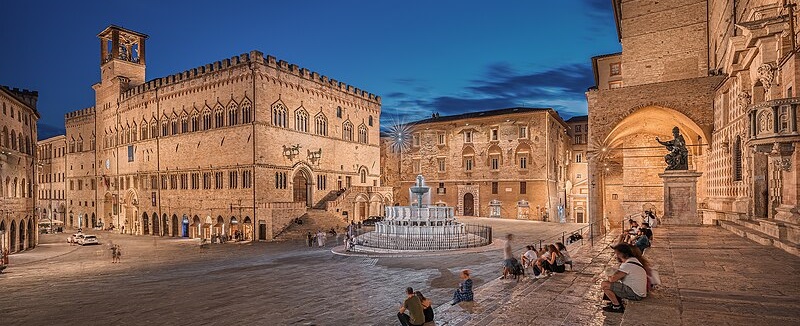Wine Region Umbria
Umbria, located in the central part of Italy, is known for its picturesque landscapes and historic towns like Assisi, Perugia, Orvieto, Spoleto, Todi, Spello and Gubbio, that offer fascinating views into their Etruscan and Roman pasts.
The capital of Umbria is Perugia.

Piazza IV Novembre in Perugia
Grapes and Wines
Umbria grows a variety of grape varieties, both indigenous and international.
Sangiovese, the grape synonymous with Tuscany, also growns in Umbria.
However, one of the unique aspects of Umbria's wine scene is the Sagrantino grape, a red variety known for its robust tannins and deep color.
Trebbiano Spoletino and Grechetto are the notable white grape varieties in the region.
Sagrantino
Sagrantino is perhaps the most famous grape of Umbria and is used to produce the powerful and tannic red wine called Sagrantino di Montefalco.
Sagrantino di Montefalco has gained recognition for its aging potential and rich, complex flavors of dark fruit, spices, and earth.
Torgiano
Torgiano is a wine-producing area in Umbria, known for its red and white wines.
Torgiano Rosso Riserva is a red wine made primarily from Sangiovese and Canaiolo and aged for a longer period for enhanced structure and complexity.
Orvieto
Orvieto is a white wine produced in the hilly town of Orvieto.
Orvieto is a blend of Grechetto (Minimum 40%) and Trebbiano (20-40%) and up to 40% of local grapes (Malvasia, Drupeggio, Verdello, Canaiolo Bianco).
Grechetto brings the fruitiness and the weight to the wine. The most highly rated examples of Orvieto have a high concentration of Grechetto.
Orvieto wines can range from dry to semi-sweet, but are most often enjoyed as an easy-drinking dry white.
Wine Tourism

Panorama of Assisi
Wine has been an integral part of Umbria's cultural and religious history. The region is known for its numerous wine-related festivals and events, celebrating the local wine culture and traditions.
The picturesque landscapes, historic towns, and vineyard-dotted countryside make Umbria an attractive destination for wine tourism.
Visitors can explore wineries, taste local wines, and immerse themselves in the region's rich cultural and culinary traditions.
Region Umbria

Climate
Umbria is characterized by rolling hills, valleys, and vineyard-covered landscapes. The region has a continental climate with hot summers and cold winters.
The diverse topography and varied elevations contribute to different microclimates well suitable for grape cultivation.
Soil
The soils vary from clay and sand in the valleys to limestone and marl in the hills.
Black Grapes |
White Grapes |

22% Sangiovese |

|
Red Wines |
White Wines |

|

|


DOCG Wines
Sagrantino Di Montefalco
Torgiano Rosso Riserva
DOC Wines
Amelia DOC
Assisi DOC
Colli Altodiberini DOC
Colli Del Trasimeno DOC
Colli Martani DOC
Colli Perugini DOC
Corbara Lake DOC
Montefalco DOC
Orvieto DOC
Rosso Orvietano DOC
Spolete DOC
Todi DOC
Torgiano DOC
Trebbiano Spolentino DOC
Alcohol can be addictive. Always drink in moderation.
© Copyright 2015-2025 W3 Wine School. All Rights Reserved.